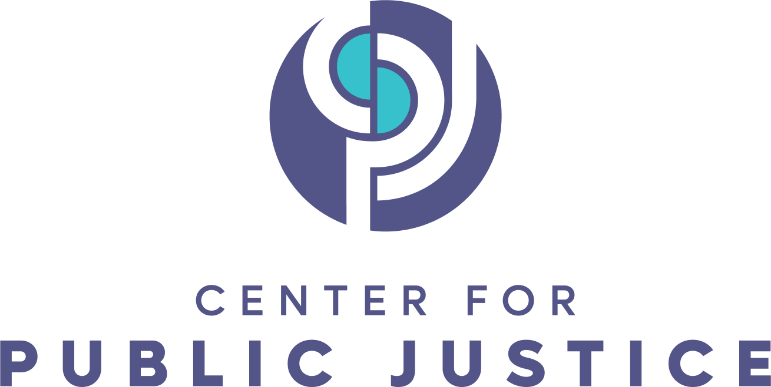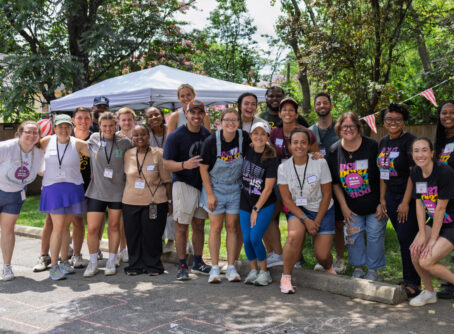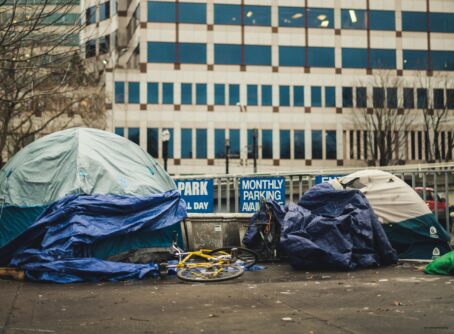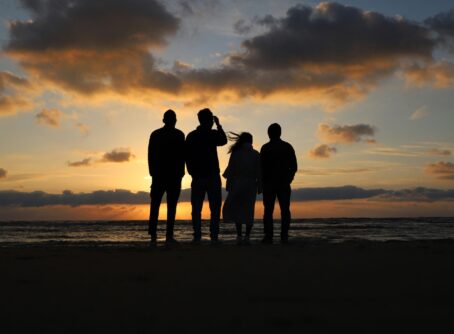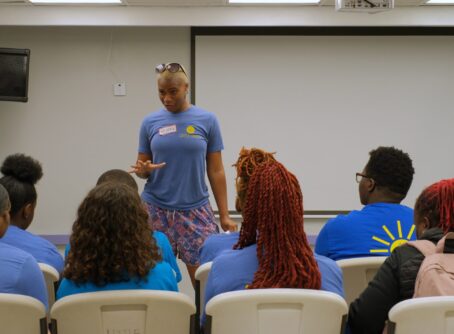
(This article emerged from a shared email exchange in the days following the Trinity Forum’s online conversation “Faith and Foreign Aid.” It represents our joint reflection and inquiry as colleagues and co-laborers in the pursuit of public justice and institutional religious freedom.)
As colleagues shaped by a commitment to principled pluralism and public justice, we often find our most fruitful conversations begin outside formal channels. Sometimes they’re stirred by the quiet promptings of the Holy Spirit—through an unresolved question or even a moment of silence that speaks volumes.
That’s what happened after we both watched the Trinity Forum’s recent event on “Faith and Foreign Aid.” It brought together Ambassador Mark Lagon, Nicole Bibbins Sedaca, and Myal Greene—leaders with deep experience in both the public and faith-based sectors. The online conversation explored the U.S. government’s engagement with faith-based organizations (FBOs) in delivering foreign assistance and other related themes. But what lingered with us most weren’t the panelists’ resumes or policy claims—it was the underlying assumptions that perhaps did not always snake it to the surface. What does institutional religious freedom actually require of FBOs when government asks them to carry its goals? And what responsibilities do faith-rooted institutions bear—not only to the people they serve, but to their donors, their traditions, and the God who called them into being?
This brief reflection is the fruit of our dialogue—a weaving together of tension and trust. We offer it not as a solution, but as a form of spiritual inquiry. We believe institutional religious freedom must be embodied to be truly real.
Partnership Is Not a One-Way Street: Reciprocity, Distinctiveness, and the Sacred Sector
Too often, government support for faith-based organizations (FBOs) is framed in paternalistic or instrumental terms: as though the federal government, in its benevolence, “permits” religious nonprofits to do charitable work, offering them a seat at the table if they comply with secular norms. That narrative misses the reality on the ground. What’s actually happening—at least when done well—is not the state “allowing” faith to serve the public good. It’s the state recognizing what has always been true: that faith-based organizations, like many community-rooted nonprofits, are embedded in relationships and systems of care that government alone cannot replicate.
Since the 1996 advent of Charitable Choice, federal law has increasingly acknowledged the unique contributions of religious institutions—not as subordinate subcontractors, but as equal partners whose religious distinctiveness is not a liability but a resource. That distinctiveness is not incidental. That is the point.
Think of two roads leading to the same public good: one is a federally constructed expressway, the kind of well-paved, top-down program delivered by a large secular provider; the other is a winding rural route stewarded by a small, faith-rooted nonprofit shaped by the rhythms and needs of its community. The destination might be the same—whether it’s refugee resettlement, quality afterschool programs, or support for housing-insecure families—but the routes are shaped by entirely different philosophies of care, rooted in different histories and communities.
Government programs that recognize only one kind of “correct” route—one delivery model, one worldview, one organizational form—choke out the pluralism that has long defined the American social sector. What makes faith-based and community organizations effective is often precisely what makes them nonstandard. A Catholic Charities shelter may emphasize dignity through sacramental hospitality. A Jewish refugee initiative might build trust through kinship structures and shared culture. A small Black Church-based social services program may provide a lifeline through its intergenerational ties and spiritual authority. These are not interchangeable with secular delivery systems. They are not deviations from a norm. They are their own forms of public good.
Federal Partnerships and the Plural Social Ecosystem
The faith-based initiative, at its best, is not a mechanism to conscript religious groups into executing a state agenda. It’s a framework of reciprocal recognition. It honors the fact that the federal government, vast though it may be, is one actor in a rich and varied social tapestry. This ecosystem includes legacy institutions and new expressions; national affiliates and neighborhood assemblies; secular professionalized providers and religious ministries shaped by sacred rhythms and rituals.
The federal government does—and should—have public goals: to offer nutrition support, to provide support to single mothers, to increase afterschool programming in underserved neighborhoods. But it should not require all its partners to look the same, act the same, or take the same route to those outcomes. That would be the civic equivalent of forcing every vehicle onto a single expressway: good intentions meet gridlock. Uniformity does not equate to efficiency when the terrain is as diverse as the communities these policies aim to serve.
This is why accommodations matter. Faith-based organizations often need flexibility around employment practices, religious messaging, or program structure. Small hyperlocal nonprofits may lack the administrative capacity of large national grantees and benefit from intermediary partnerships or technical assistance. These are not loopholes—they are the necessary infrastructure of a pluralist public square.
Reciprocity, Not Reliance
Let me tell you a secret: I’ve always been uneasy with the term “faith-based initiative.” Useful in some contexts, yes. But it flattens a far more complex landscape. It risks suggesting that this is only about faith, or only about service delivery. In reality, it’s about the right role and responsibility of religious and community-based organizations within a civil society that values distinctiveness, integrity, and trust.
Partnership should not mean dependency. FBOs, like any nonprofit, should not over-rely on a single funding source, whether government or philanthropic. Nor should the state view these groups as delivery arms to be molded into ideological conformity. The goal is mutuality. Not assimilation.
That is why Charitable Choice and its successors (like the Equal Treatment rules) have tried—however imperfectly—to protect the distinctiveness of religious and other distinct organizations within federally funded partnerships. And yet, under different administrations, these protections are often threatened: by secularizing pressures on the left, or by libertarian abandonment on the right.
Too many progressives want the state to guarantee every human good as a public entitlement—housing, income, education—without always considering the role of civil society in actually delivering these goods and services sustainably. On the flip side, some conservatives downplay structural needs altogether, hiding behind personal responsibility mantras that ignore the role of institutions and systems. In both cases, the distinctive witness of faith-based organizations—both their theological commitments and their embedded community roles—gets erased.
This is not just about funding models. It’s about institutional religious freedom. It’s about whether our public square has room for organizations whose practices are shaped by beliefs not shared by all.
When we talk about “freedom of religion,” we often think of individuals. But freedom is also institutional. Religious organizations are not mere collections of individuals; they are formational communities. They hold together practices, traditions, stories, and truths that cannot always be broken into secular, modular parts. That integrity is precisely what makes them valuable public partners.
Take refugee resettlement. This is a deeply government-mediated field. FBOs cannot welcome refugees if the federal government halts the program. But when government does allow it, faith-based groups are often the ones who do the work no one else will—finding landlords, providing community orientation, offering trauma-informed pastoral care. If those groups are required to strip their identity to qualify for funding, we lose not only religious freedom but also effectiveness. We lose trust. We lose presence. We lose the “why” behind the service.
This is what faith-based organizations often struggle with. The frustration isn’t that government has a role—it’s that the government sometimes forgets its role is not to remake civil society in its own image, but to enable it to flourish.
A Public Square Worth Sharing
At its core, the faith-based initiative is a public theology of partnership. It says the state does not have to do everything, nor should it try. It says the public square is big enough to accommodate difference—not just in opinion, but in institutional identity and sacred commitments. It says the work of public justice is not only in the delivery of goods, but in the dignity of the relationships that carry them.
That’s why partnership must be a two-way street. Not just government enabling FBOs, and not just FBOs executing state agendas—but mutual recognition, reciprocity, and reverence for the plural paths that lead toward the common good.
Legal freedom—religious staffing rights, protected speech, capacity to serve the whole person—is essential. But it is not sufficient. Just because an FBO can accept government funds doesn’t mean it should.
We must ask harder questions of ourselves. Are we forming institutional cultures resilient enough to say no to grants that dilute mission? Are our programs still rooted in spiritual formation, or have they been reduced to technocratic outputs? Are we preserving the particularity that makes faith-based presence unique?
Research from the Baylor Institute for Studies of Religion and the Independent Sector shows that organizations deeply reliant on public funding are more likely to adapt mission language and shift strategic priorities to align with federal goals. Over time, this produces an unintentional drift—a slow erosion of ecclesial imagination in favor of performance metrics.
As one of us put it bluntly: Are we crafting proposals that reflect who we are, or who we think will get funded?
Discernment means more than compliance. It means pausing long enough to ask whether a funding stream reinforces our sacred identity or compromises it. It also means forming boards, staff, and donor bases who understand that sustainability is not the same as survivability.
World Relief’s intentional diversification of funding—and their theological clarity about who they are—offers a template. But it’s not the only model. What matters is the posture: a commitment to not lose our soul in the process of doing good.
When Government Withdraws, Who Remains?
The scale of the recent foreign aid cuts—over $50 billion—is staggering. But the damage goes beyond budget line items. What’s unraveling is an entire web of relational capital, local trust, and institutional infrastructure—particularly among faith-based organizations serving in fragile regions. When federal dollars vanish, staff are laid off, community programs collapse, and decades of trust built by local and religious institutions erode in a single budget cycle.
This is not just a policy failure. It’s a spiritual and institutional reckoning. What does it say about our public values when entire faith-rooted infrastructures—ones that often serve as the last thread of hope in conflict zones and refugee camps—can be undone overnight by a shift in federal priorities?
Among some conservative policymakers, foreign aid is seen as a misuse of taxpayer money: funding corruption abroad, subsidizing dependency, or funneling dollars to regimes hostile to American interests. There is merit in insisting on accountability, transparency, and alignment with national priorities. But too often, these critiques paint with too broad a brush, failing to distinguish between bloated bureaucratic spending and strategic, partnership-driven aid grounded in grassroots networks—including faith-based organizations with decades of trust and track records.
Here’s what’s missing: foreign aid is not only about generosity. It’s about stability. It’s about preventing displacement before it becomes a migration crisis. It’s about supporting religious freedom and civil society in places where extremism thrives on chaos. And it’s about fostering goodwill in a world where America’s moral influence is being contested.
Faith-based actors—churches, clinics, relief agencies, and diaspora communities—are often the most effective channels for this aid, especially in areas where government systems are weak or untrusted. When we cut funding to these groups, we don’t just “save money.” We abandon the tools that make diplomacy relational, security preventative, and American values tangible.
Beyond Scarcity: A Theology of Presence and Provision
Still, we must face a second, harder question: Are our institutions built to endure scarcity? If our sacred calling is to remain present—to embody mercy, hospitality, and constancy—then we must be prepared to minister in the wilderness, not just the feast. That doesn’t mean rejecting all government support. But it does require us to cultivate institutional resilience—not dependency.
For decades, faith-based organizations have done remarkable work in partnership with the federal government. But partnership cannot become overreliance. If every ministry collapses with a federal budget cut, something deeper has been lost than funding—we’ve lost our grounding in a theology of provision. Do we still believe that God sustains people through God’s people—not just through public funding streams?
This is not a call to retreat from the public square. On the contrary, it is a call to reimagine public justice as a form of covenantal stewardship—one that includes both state and civil society actors, but does not collapse them into each other.
Let’s be clear: faith-based organizations should not be expected to fill every gap left behind by the state. That assumption—whether made by progressive technocrats or libertarian conservatives—is itself unjust. But neither should FBOs be caught unprepared when political winds shift. Resilience is not retreat. It is the muscle memory of prophetic presence. It is how institutions remain present even when policies change.
That’s why the conversation around foreign aid should not be reduced to a debate between “charity abroad” versus “need at home.” It is a false binary. America’s security, moral credibility, and public witness are strengthened when we stand with the world’s most vulnerable—especially through partners who embody a different logic than power alone.
In the end, the question is not whether aid serves “us” or “them.” It’s whether we believe public justice includes the call to endure, to respond with faith when others withdraw, and to serve not only from abundance but from conviction.
Faith-based organizations have often remained when others leave. The challenge now is to build institutions and funding models that reflect that sacred commitment—not just to presence, but to perseverance.
Love Ordered Toward the Stranger
Some Christians argue that we should care for “our own” first—that charity begins at home, and that government funding for foreign aid violates an order of affections. But rightly ordered love, ordo amoris, is not tribalism.
In Scripture, the widow, the orphan, the stranger, and the poor are not add-ons to covenantal faithfulness. They are its measure.
Still, there are good questions—like: What is the return on investment for American taxpayers when we fund international aid? Shouldn’t we be able to show tangible benefits?
Yes—and we can. Scholars at the Center for Strategic and International Studies and Georgetown’s Berkley Center have documented how strategic, locally rooted aid—especially when deployed through trusted faith-based partners—reduces conflict, curbs forced migration, improves health outcomes, and opens channels of diplomacy. That’s not theoretical. That’s stewardship.
But we should go deeper still. Foreign aid is not merely transactional. It is a moral extension of our civic vocation. If we believe in covenantal responsibility—that we are called to seek the good of others, even when we cannot see the return—then our national life should reflect that.
Institutional Freedom Requires Institutional Depth
The current moment invites a reframing of religious freedom—not as reactive protection, but as constructive responsibility. Religious institutions, when healthy, are not just beneficiaries of liberty. They are makers of meaning, weavers of civic trust, bearers of the Sacred.
But that depth must be cultivated. Not every FBO is formed to carry public trust. Not every program should be scaled. And not every partnership should be preserved.
This is where we must make peace with our limits. Faith-based organizations should not try to be all things to all agencies. We should not surrender our spiritual grammar to speak the language of metrics alone.
Instead, we need more institutional rootedness—places where the sacred is not tacked on to the social, but interwoven from the start. Where discernment is practiced communally. Where the freedom to be distinct is held together with the responsibility to serve sacrificially.
Chelsea Langston Bombino is a believer in sacred communities, a wife, and a mother. She serves as a program officer with the Fetzer Institute and a fellow with the Center for Public Justice.
Girien R. Salazar, Ph.D. is the Director of Faith-Based Policy and Research at the Center for Public Justice.
